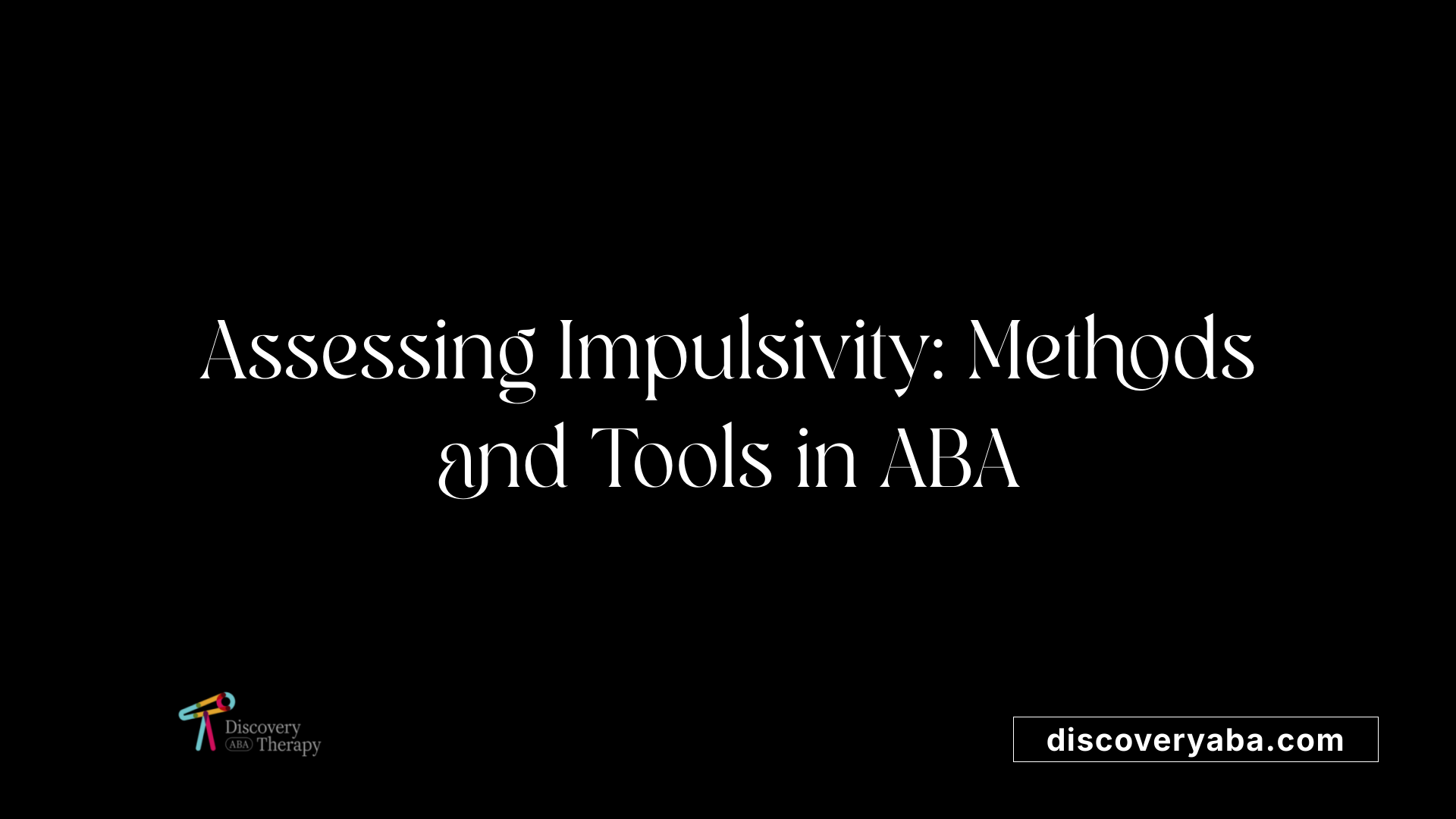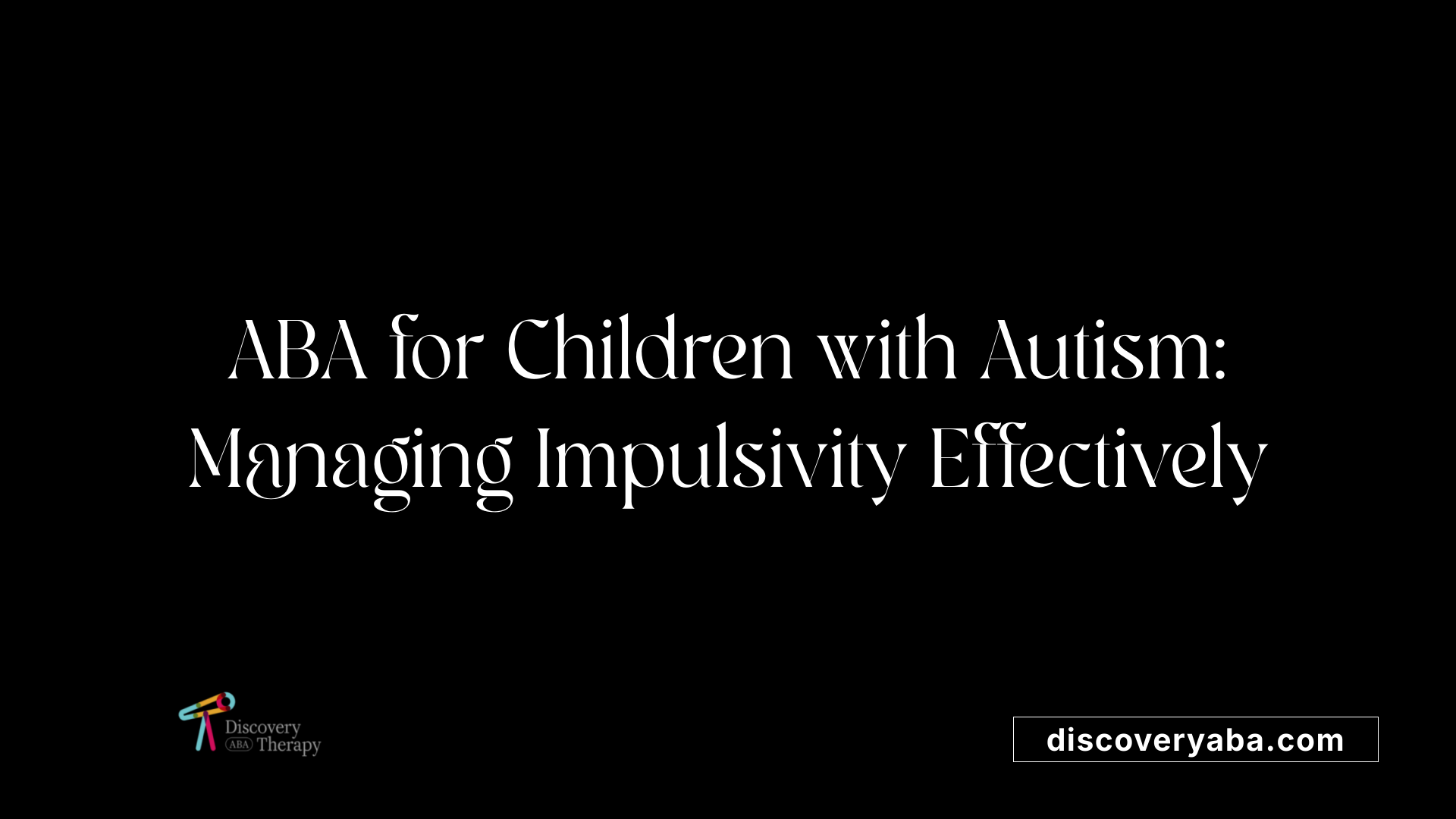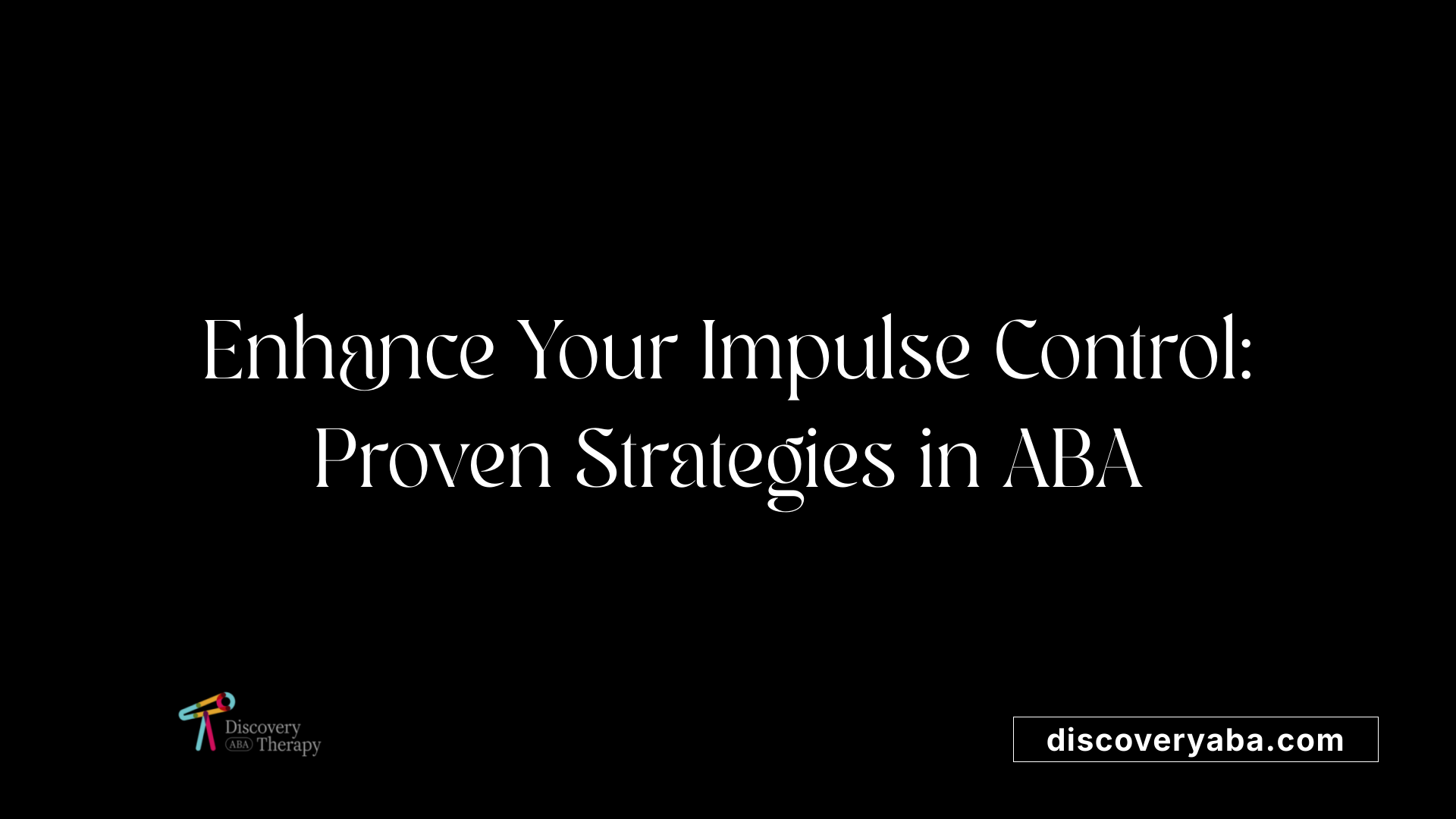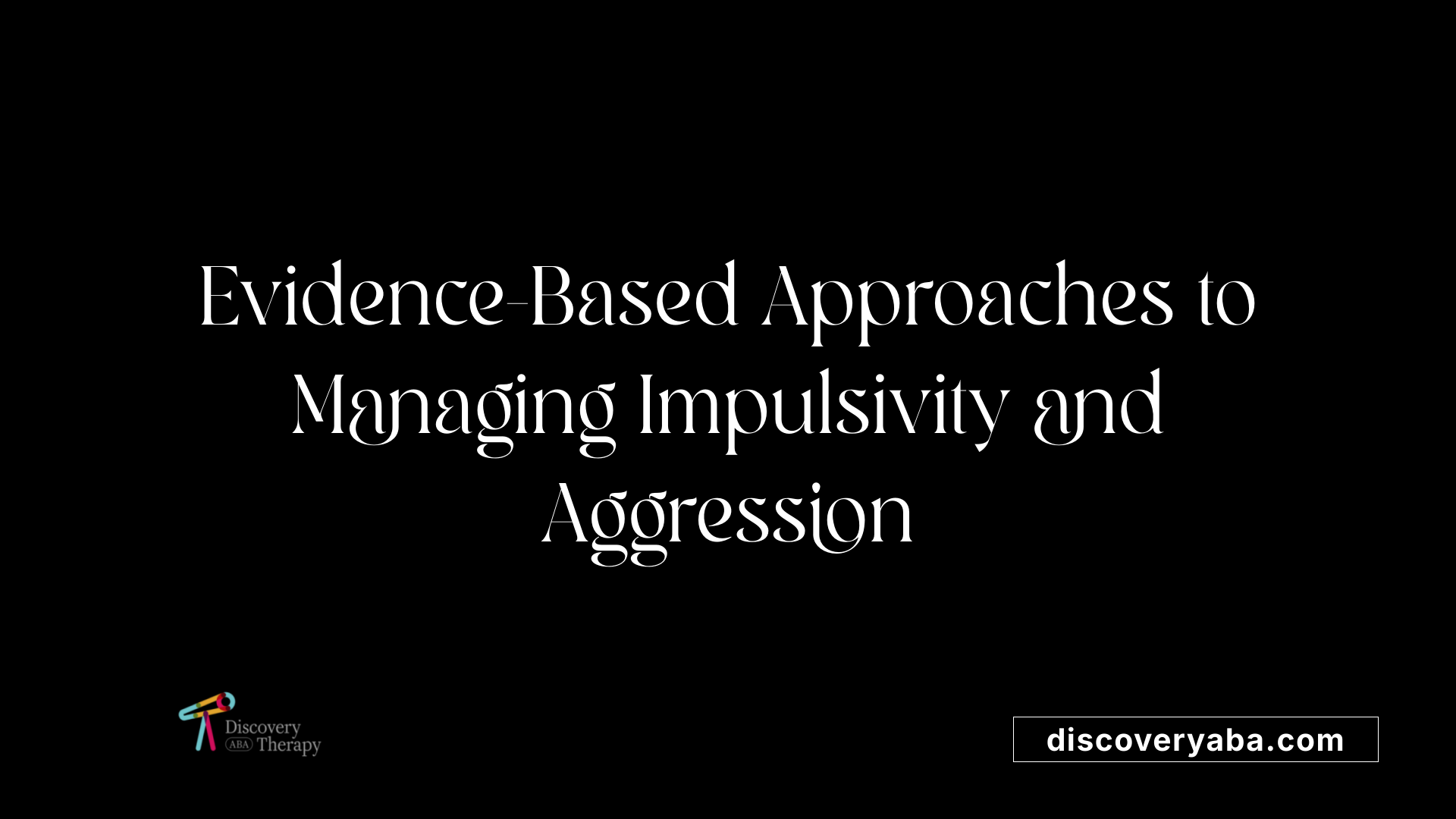ABA approaches to reducing impulsive behaviors
Harnessing ABA Techniques to Manage Impulsivity Effectively

Understanding and Addressing Impulsive Behaviors Through ABA
Impulsivity is a common challenge across various populations, including children with autism, individuals with ADHD, and adults in controlled environments. Applied Behavior Analysis (ABA) offers a scientific, evidence-based approach to understanding and reducing impulsive behaviors through systematic interventions. By identifying the functions of impulsivity and implementing targeted strategies, ABA empowers individuals to develop better impulse control, enhancing social, emotional, and everyday functioning.
Assessing Impulsivity in ABA Therapy

How are impulsivity and impulsive behaviors assessed within ABA therapy?
Impulsivity and impulsive behaviors are evaluated using a combination of observational and assessment techniques to ensure a comprehensive understanding of each individual. Direct observation plays a crucial role, allowing therapists to monitor behaviors in natural settings like home, school, or therapy sessions, as well as structured environments designed to elicit specific responses.
Functional behavior assessments (FBA) are fundamental in identifying the triggers and purposes behind impulsive actions. These assessments involve interviews with caregivers and teachers, direct observation, and data collection to pinpoint what prompts impulsive behaviors and their consequences.
Standardized tools such as questionnaires, rating scales, and impulse control worksheets are also employed. These tools gather detailed information about the severity and frequency of impulsivity, providing a quantifiable measure to track progress over time.
In some cases, especially with populations like children with ADHD, computer-based assessments are used. These digital evaluations simulate decision-making scenarios and manipulate variables such as delay of reinforcement, effort required, or distractibility, helping to reveal specific factors that influence impulsive choices.
A critical part of assessment involves collecting data consistently over days or weeks. Recognizing patterns and contextual factors helps clinicians understand when and why impulsivity occurs, guiding personalized intervention plans.
Input from therapists, caregivers, and teachers further enriches the evaluation. Their observations about behavior onset, situations that escalate impulsivity, and responses to interventions allow for a well-rounded understanding.
Overall, this multi-method approach in ABA therapy provides a detailed picture of impulsivity, enabling practitioners to develop tailored strategies to strengthen impulse control and improve daily functioning.
Core ABA Techniques for Reducing Impulsivity

What are common ABA techniques used to reduce impulsive behaviors?
Applied Behavior Analysis (ABA) offers several effective methods to help individuals manage impulsivity. Central to these techniques is the use of positive reinforcement, which encourages desired behaviors by rewarding appropriate responses. For example, when a person demonstrates patience or self-control, they receive praise or tangible rewards, reinforcing these positive habits.
Another important technique is Functional Communication Training (FCT), which teaches individuals to express their needs and frustrations through acceptable communication methods instead of impulsive reactions like aggression or tantrums. This skill reduces the likelihood of impulsive outbursts by providing alternative ways to signal discomfort or requests.
Environmental modifications also play a vital role. Visual supports such as picture schedules, timers, and social stories clarify expectations and routines, helping individuals understand what to anticipate and reducing anxiety that may trigger impulsivity. Role-playing and modeling are practical strategies where the individual practices healthier responses in simulated scenarios, fostering learning and generalization across settings.
Self-regulation skills are promoted through techniques like waiting strategies, relaxation exercises, and mindfulness practices. These tools assist individuals in recognizing their emotional states and managing their reactions effectively.
Establishing predictable routines and making changes to the environment—like providing sensory spaces or scheduled breaks—create a structured setting that minimizes surprises and helps the person stay calm.
Ongoing evaluation through Functional Behavior Assessments (FBAs) allows clinicians to identify specific triggers—such as sensory overload or social stress—that lead to impulsive behaviors. Once understood, personalized behavior support plans can be developed, combining these techniques for maximum effectiveness.
In summary, combining positive reinforcement, communication skill development, environmental adjustments, self-regulation training, and continuous assessment forms a comprehensive approach to reducing impulsivity through ABA.
ABA Applications for Children with Autism
 Applied Behavior Analysis (ABA) offers practical tools to help children with autism improve their impulse control and overall behavior. Central to this approach is the development of individualized behavior plans, which are created following a detailed assessment known as a Functional Behavior Assessment (FBA). The FBA uncovers the reasons behind behaviors, guiding targeted interventions.
Applied Behavior Analysis (ABA) offers practical tools to help children with autism improve their impulse control and overall behavior. Central to this approach is the development of individualized behavior plans, which are created following a detailed assessment known as a Functional Behavior Assessment (FBA). The FBA uncovers the reasons behind behaviors, guiding targeted interventions.
One of the most effective ABA strategies involves positive reinforcement and Functional Communication Training (FCT). These methods teach children appropriate ways to express their needs, which reduces behaviors driven by frustration or unmet desires. For example, a child might learn to ask for a break instead of acting out impulsively.
Self-management techniques are also incorporated, such as using timers, visual schedules, and mindfulness exercises. These tools empower children to recognize their emotions and manage their impulses in real-time. Visual supports like picture schedules or social stories help children understand expectations and social cues, decreasing confusion and impulsive reactions.
Environmental modifications further support impulse control by creating calming spaces or using visual aids to reduce sensory overload. Establishing predictable routines and quiet zones can lower anxiety and impulsivity.
During impulsive outbursts, caregivers and therapists are trained to respond with calm and neutral redirection. This approach involves avoiding reactive behaviors such as punishment or eye contact, instead guiding the child to engage in acceptable behaviors.
Overall, integrated ABA tactics aimed at emotion regulation, communication enhancement, and environmental adjustment provide meaningful support for children with autism in managing impulsivity, leading to better social engagement and adaptive skills.
Strategies for Enhancing Impulse Control

How do structured routines and consistent rules help in managing impulsivity?
Establishing predictable routines creates a sense of stability and safety, reducing anxiety that may trigger impulsive reactions. Consistent rules provide clear expectations, making it easier for individuals to regulate their actions and respond appropriately. Visual supports like picture schedules and social stories reinforce understanding and help individuals anticipate what comes next, further decreasing impulsivity driven by uncertainty.
What role do token economies and contingency management systems play?
In both child and adult settings, token economies serve as motivational tools by awarding tokens for desirable behaviors such as patience and self-control. These tokens can later be exchanged for rewards, reinforcing positive habits. Contingency management systems include delayed reinforcement strategies, especially in high-risk environments like rehabilitation centers or prisons. They help control impulsivity by linking behavior with tangible incentives, which are systematically maintained and withdrawn based on the individual's actions.
How can mindfulness and stress reduction techniques aid impulsivity regulation?
Practicing mindfulness, relaxation exercises, and stress management techniques increase self-awareness of emotional states. These practices help individuals recognize early signs of impulsivity, allowing them to employ coping strategies like deep breathing or focused attention to stay calm. Although the effectiveness of specific mindfulness approaches varies, many see these methods as valuable tools for emotional regulation.
What targeted skills are developed to improve decision-making and delay gratification?
Training in delay discounting and effort-based decision-making helps individuals evaluate long-term benefits over immediate pleasures. Techniques focus on teaching patience, self-control, and effortful choices, gradually strengthening their ability to manage impulsive urges. When integrated with reinforcement strategies, these skills can lead to sustainable improvements in self-regulation and social functioning.
| Strategy | Description | Impact on Impulsivity |
|---|---|---|
| Structured routines and rules | Establishing predictable daily patterns and clear expectations | Reduces anxiety, promotes self-control |
| Token economies and contingency systems | Using tokens or rewards to reinforce positive behavior | Motivates and maintains behavioral improvements |
| Mindfulness and stress management | Techniques like meditation, breathing exercises | Enhances awareness, reduces reactive impulses |
| Decision-making skill training | Teaching delay gratification and effort-based choices | Improves long-term self-control and impulse regulation |
By combining these approaches, individuals can better manage impulsive behaviors, leading to improved social interaction, emotional stability, and overall well-being.
Evidence-Based Practices in Managing Impulsivity and Aggression

What are evidence-based practices in ABA for addressing impulsive and aggressive behaviors?
Applied Behavior Analysis (ABA) employs several well-supported methods to help individuals manage impulsivity and aggression. Central to this approach is the use of Functional Behavior Assessments (FBA), which explore the triggers and reasons behind problematic behaviors. By gathering information through interviews, direct observation, and data collection, professionals identify what causes the behaviors and what functions they serve for the individual.
Based on these insights, personalized intervention plans are created. Positive reinforcement plays a major role by rewarding desired behaviors, encouraging individuals to adopt more appropriate responses. Differential Reinforcement of Alternative behaviors (DRA) specifically emphasizes reinforcing behaviors that serve the same function as aggression but are socially acceptable.
Visual supports, such as picture schedules and social stories, help improve understanding and communication, decreasing impulsive reactions caused by frustration or confusion. Social stories are tailored narratives that help individuals recognize social cues and practice suitable responses.
Neutral redirection is another effective technique. It involves calmly redirecting an individual without reacting negatively or punishing aggressive acts. For example, caregivers might use visual indicators like timers or hand signals to acknowledge requests while signaling a delay or alternative option.
Contingency management systems, including token economies, are prominent especially in adult and high-risk settings. Here, individuals earn tokens for appropriate behaviors, which can be exchanged for privileges or rewards. This system has been validated through research, showing significant reductions in impulsivity and aggression.
Together, these evidence-based practices provide a comprehensive framework for reducing impulsive and aggressive behaviors. They focus on understanding motives, teaching alternative skills, and reinforcing positive responses, all within a scientifically supported structure.
Target Skills for Impulse Regulation in ABA
What skills are targeted in ABA to help individuals regulate impulsive behaviors?
In Applied Behavior Analysis (ABA), the primary focus is on developing specific skills that enhance impulse control and emotional regulation. Therapists work to teach individuals how to manage their emotions, recognize their reactions, and practice self-control. These skills are cultivated through positive reinforcement, modeling appropriate social behavior, and implementing exercises that foster self-awareness.
One effective approach involves social skills training using social stories and scripts. These tools help individuals understand social cues, appropriate responses, and how to navigate social interactions calmly. Activities like "Freeze and Focus" or "The Waiting Game" are designed to teach patience and delay gratification, helping reduce impulsive reactions.
Calming techniques such as deep breathing, mindfulness exercises, and sensory calming strategies also play a vital role. Sensory spaces and breaks allow individuals to self-regulate during moments of sensory overload. These activities support emotional control and promote a state of calmness.
Self-monitoring and self-awareness are reinforced through routine check-ins and visual cues, enabling people to recognize their feelings and behaviors before acting impulsively. Overall, ABA combines behavioral strategies and skill-building exercises to support better impulse management and foster adaptive responses in various settings.
Applying ABA Interventions in Practice
ABA therapy offers practical strategies that can effectively address impulsivity by teaching individuals how to manage their behaviors in different settings.
One widely used approach involves visual supports, such as picture schedules, social stories, timers, and video modeling. These tools help individuals understand what to expect and what behaviors are appropriate, providing clear cues that reduce uncertainty and impulsive reactions.
Reinforcement strategies are fundamental in encouraging desired behaviors. Positive reinforcement, like praise or tokens, increases the likelihood of self-regulation and patience. For example, a child may earn a reward for waiting their turn. In some cases, negative reinforcement—removing an unpleasant stimulus when the individual displays control—also encourages calm behavior.
Teaching new skills often involves prompting, fading, and chaining techniques. Prompting provides reminders or cues to guide behavior, which are gradually faded as the individual gains independence. Chaining involves linking simple behaviors into more complex sequences, helping manage impulsive responses by teaching structured steps.
Real-time behavior management can benefit from neutral redirection, where caregivers calmly redirect disruptive behaviors without giving them attention or rewards. This approach minimizes reinforcement of aggression or impulsivity.
Positive feedback is crucial in reinforcing progress. Praising appropriate behavior during stressful situations helps the individual associate good responses with praise, motivating continued self-control.
All these strategies are supported by a structured routine and environmental modifications like reducing distractions and preparing them for unexpected events. These modifications, combined with consistent practices, foster a predictable environment that enhances impulsivity management over time.
Overall, ABA interventions rely on behavioral principles—modeling, reinforcement, guided practice, and environmental adaptations—to develop self-regulation skills that improve social, emotional, and functional outcomes for individuals managing impulsivity.
Summary and Future Directions in ABA for Impulsivity Management
ABA provides a comprehensive framework for understanding and diminishing impulsive behaviors through assessment, tailored interventions, and ongoing skill development. By leveraging evidence-based strategies like positive reinforcement, functional communication training, visual supports, and environmental modifications, practitioners can effectively teach impulse control skills. Continued research into innovative techniques such as mindfulness training and targeted decision-making interventions promises to enhance ABA's efficacy further. As the field advances, integrating multidisciplinary approaches and expanding caregiver training will remain crucial to fostering sustainable behavioral improvements and improving quality of life for individuals managing impulsivity.
References
- ABA Therapy for Impulse Control | Childwise
- How to Reduce Impulsive Behavior in Autism - Jade ABA Therapy
- ABA in the Treatment of Aggression and Impulse Control
- Applied Behavior Analysis in Treating Aggression and Impulse ...
- ABA Therapy for Impulse Control | Childwise
- Applied Behavior Analysis in Treating Aggression and Impulse ...
- ABA Therapy for ADHD: Effective Strategies for Kids
- ABA in the Treatment of Aggression and Impulse Control
Does Your Child Have An Autism Diagnosis?
Learn More About How ABA Therapy Can Help
Find More Articles
Contact us
North Carolina, Nevada, Utah, Virginia
New Hampshire, Maine
Arizona, Colorado, Georgia, New Mexico, Oklahoma, Texas
.avif)


































































































